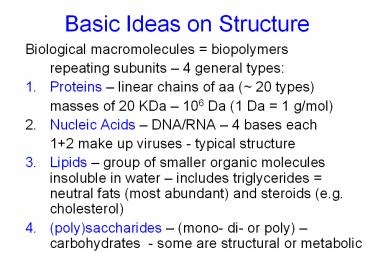Basic Ideas on Structure - PowerPoint PPT Presentation
Title:
Basic Ideas on Structure
Description:
... membrane protein packaging assembly Other small organelles + small molecules + proteins 100 nm3 600 of these in E coli Some Central Question in Biophysics What ... – PowerPoint PPT presentation
Number of Views:109
Avg rating:3.0/5.0
Title: Basic Ideas on Structure
1
Basic Ideas on Structure
- Biological macromolecules biopolymers
- repeating subunits 4 general types
- Proteins linear chains of aa ( 20 types)
- masses of 20 KDa 106 Da (1 Da 1 g/mol)
- 2. Nucleic Acids DNA/RNA 4 bases each
- 12 make up viruses - typical structure
- Lipids group of smaller organic molecules
insoluble in water includes triglycerides
neutral fats (most abundant) and steroids (e.g.
cholesterol) - (poly)saccharides (mono- di- or poly)
carbohydrates - some are structural or metabolic
2
Cells are compartmentalized
- Cell size 1 100 um 1 m (nerve cell)
- E coli example
- Careful about thinking of these images as static
there is lots of motion going on - For example, a 160,000 Da typical protein would
diffuse its own size of 10 nm in about 2 us in
water, but in concentrated cytoplasm it takes
about 1000x longer or 2 ms.
3
outer
inner
Membrane production
- UPS packaging
4
Energy production
5
Cytoplasm components
- Structural proteins
- microfilaments (actin), microtubules (tubulin)
and intermediate filaments (diverse) - Ribosomes site of protein synthesis
- Mitochodria site of energy production
- Golgi apparatus stacked membrane protein
packaging assembly - Other small organelles small molecules
proteins
6
100 nm3 600 of these in E coli
7
Some Central Question in Biophysics
- What is detailed Structure?
- Structure/Function Relations
- Role of flexibility/ motions
- Structural Motifs calculate possible numbers
- Protein folding problem
- Effect of single-site specific genetic changes
- Ligand-macromolecule interactions
- Regulation/Control of Structure/Function processes
8
Key areas of Current Study
- 1. Structure/Function relations in
proteins/DNA/complexes - Membranes Channels
- Motor proteins/molecular machines
- Photo-biophysics
- Imaging/Microscopy/New techniques
9
Sample Preparation Overview
- Organisms
- 1. Bacteria most studied easy, fast to grow
large quantities genetic engineering - 2. Complex mammalian whole body, organ
(heart, kidneys), medical applications - Components
- 1. Cells tissue culture stem cell lines!
motility, growth, communication - 2. Isolated macromolecules typical prep
10
Typical Protein Prep
CELLS/ORGANS
Extraction
Homogenize freeze-thaw sonicate
CRUDE EXTRACT
Remove nucleic acids add precipitating agents
like protamine sulfate
Differential Sedimentation
CRUDE PROTEIN FRACTION
Salting out with NH4SO4 or organics
Differential Sedimentation
PARTIALLY PURIFIED PROTEIN
Chromatography/Electrophoresis
Several rounds and types (affinity C 1 step)
PURIFIED PROTEIN
11
Tests of Purity
- For purity of Protein
- 1. Does it crystallize?
- 2. Analytical ultracentrifuagation
- 3. SDS gel electrophoresis
- 4. Can specific activity (if an enzyme) be
increased? - For purity of Form
- 1. Analytical ultracentrifugation
- 2. Light scattering
- 3. EM
- 4. Others
- Precautions Keep Cold, Work Fast, Beware of
Surface Denaturation
12
How do we learn about DNA/Proteins?
- Look at them EM, laser manipulation
- Watch them move light hydrodynamic methods
- Measure a signal from them NMR, ESR,
Fluorescence, - Attach a label to them and monitor a signal
- Fluorescence,
- 5. Look at them with x-rays when a crystal is
available































